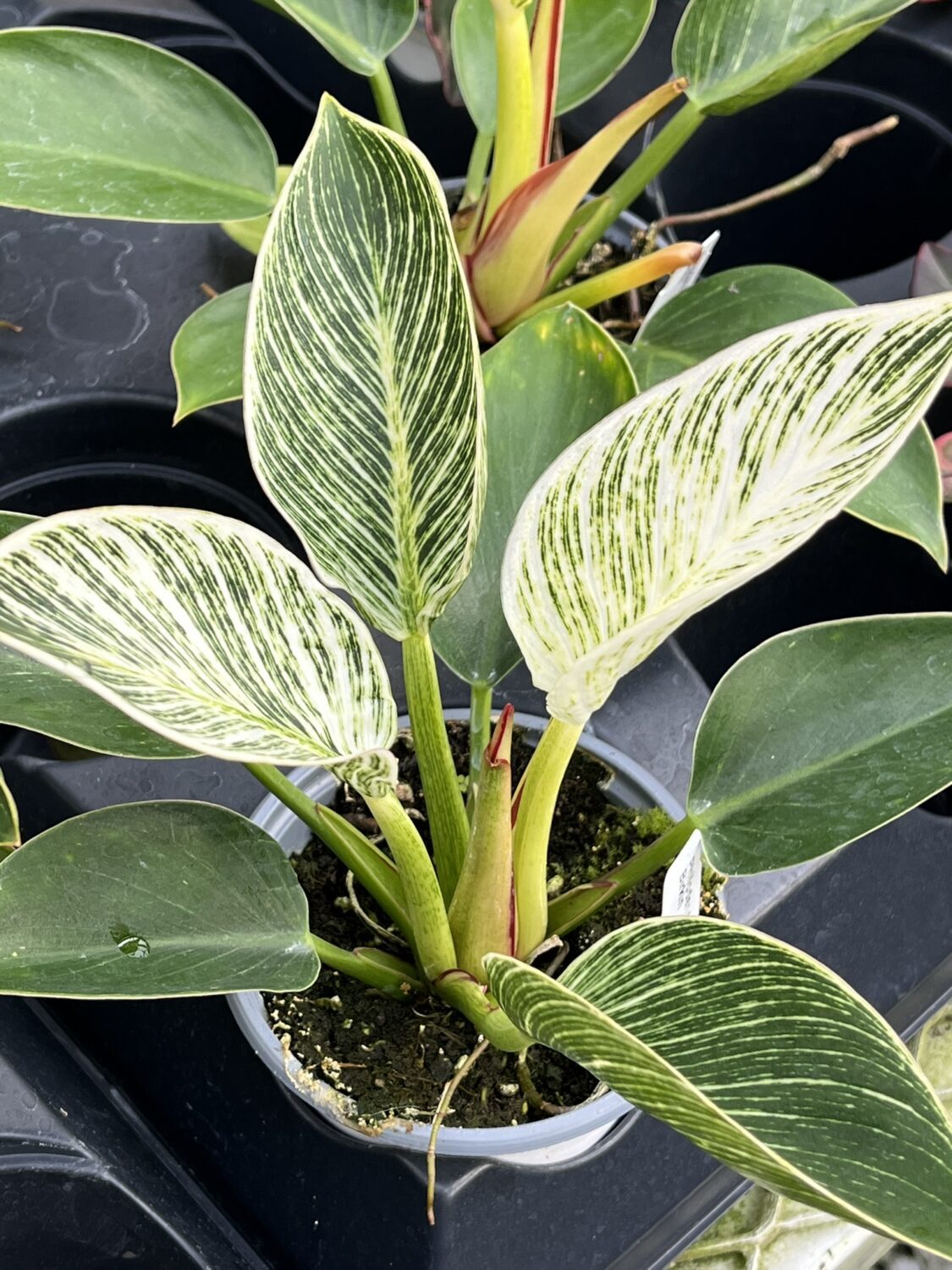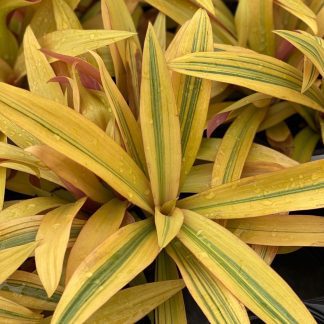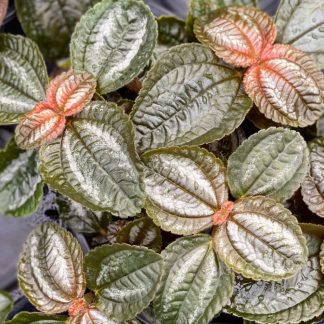Description
Philodendron Hybrid ‘Birkin’: A Stylish Green Companion
The Philodendron hybrid ‘Birkin’ is a tropical plant that has captured hearts everywhere. With bold pinstriped leaves and a compact, tidy shape, it offers style and charm without fuss. This plant blends tropical beauty with easy care, making it a favorite for homes, offices, and cozy spaces alike.
A Quick Look at the Philodendron ‘Birkin’
The ‘Birkin’ is part of the Araceae family, known for lush, leafy plants with strong tropical vibes. It is believed to be a natural mutation of the Philodendron Rojo Congo. Over time, plant lovers embraced it for its striking foliage and moderate size.
Unlike many other Philodendrons, the ‘Birkin’ grows upright and stays neat. Its leaves are glossy green, streaked with creamy-white pinstripes that stand out in any room. Most plants reach about 1 to 3 feet tall, a perfect size for tables, shelves, or even a small corner display.
Why the ‘Birkin’ Is Worth Adding to Your Collection
-
Striking Appearance: The creamy-white stripes against dark green leaves make this plant look almost painted.
-
Compact Size: Its moderate height and upright growth work well in both big and small spaces.
-
Easy Care: Like other Philodendrons, it doesn’t need constant attention to thrive.
-
Air Purifying: It helps clean indoor air by removing certain toxins.
-
Conversation Starter: Visitors will likely ask about it, thanks to its unique pattern.
Growing and Caring for Your Philodendron ‘Birkin’
Caring for the ‘Birkin’ is straightforward once you understand its tropical roots. Mimicking its native conditions will help it flourish indoors.
1. Light Needs
The ‘Birkin’ loves bright, indirect light. Too much sun can damage its leaves, while too little can fade its pinstripes.
-
Best Location: Near an east- or north-facing window with filtered sunlight.
-
Protection: Use a sheer curtain to soften strong light from a south- or west-facing window.
-
Low Light: It can adapt, but the leaves may lose their vivid stripes. A grow light can help in darker rooms.
2. Watering Routine
Watering correctly is key to a healthy ‘Birkin.’ Overwatering is a common mistake.
-
When to Water: Check the top 1–2 inches of soil. If it’s dry, water. Usually, this means every 7–10 days.
-
Drainage: Always use a pot with drainage holes. Empty the saucer after watering.
-
Water Temperature: Room-temperature water is best to prevent root shock.
3. Humidity and Temperature
This plant thrives in warm, humid air, much like its tropical origin.
-
Temperature Range: Keep between 65–80°F (18–27°C). Avoid cold drafts or heat vents.
-
Humidity Level: Aim for 50% or higher. To boost humidity:
-
Use a humidifier.
-
Place the pot on a pebble tray with water.
-
Group it with other plants to create a moisture pocket.
-
Lightly mist the leaves in dry seasons.
-
4. Soil and Repotting
A loose, well-draining soil mix is vital for healthy roots.
-
Soil Mix: Combine potting soil, peat moss, and perlite or orchid bark.
-
Repotting Schedule: Every 1–2 years or when roots outgrow the pot. Choose a container just 1–2 inches larger.
5. Fertilizing
Feed your ‘Birkin’ regularly during its growing season for steady growth.
-
Fertilizer Type: A balanced, water-soluble mix like 10-10-10 works well.
-
How Often: Every 4–6 weeks in spring and summer. Pause feeding in fall and winter.
-
Dilution: Always dilute fertilizer to half-strength to prevent root burn.
6. Pruning and Basic Care
Minimal pruning keeps the plant tidy and encourages fresh growth.
-
Remove Yellow Leaves: Trim dead or damaged leaves to redirect energy.
-
Shape Control: If it grows too tall or wide, cut back gently with clean scissors.
-
Leaf Cleaning: Wipe leaves with a damp cloth to remove dust and boost shine.
7. Pests and Problems
The ‘Birkin’ is hardy but can face occasional pests or health issues.
-
Pests to Watch For: Spider mites, mealybugs, and scale insects. Treat with neem oil or insecticidal soap.
-
Root Rot: Caused by overwatering or poor drainage—fix by improving soil and pot setup.
-
Fungal Spots: Ensure good airflow and avoid water sitting on leaves.
8. Propagation
Sharing a ‘Birkin’ is easy through stem cuttings.
-
Cutting Method: Take a stem with at least one node and a few leaves.
-
Rooting Medium: Place in water or moist soil. Refresh water weekly if rooting in water.
-
Timeline: Roots usually form in 4–6 weeks. Transfer to soil once well-rooted.
Styling Ideas for the Philodendron ‘Birkin’
The ‘Birkin’ blends beautifully into many decor styles. Here are creative ways to display it:
-
Standalone Feature: Use a modern ceramic pot to highlight its bold leaves on a coffee table or shelf.
-
Grouped Display: Combine with Monstera, Pothos, or Calatheas for a tropical cluster.
-
Raised Planters: Elevate in a plant stand or hanging pot to admire its foliage from all sides.
Troubleshooting Common Issues
Even easy-care plants have challenges. Here’s what common symptoms mean:
-
Yellowing Leaves: Often overwatering or poor drainage—check soil moisture and pot holes.
-
Brown Tips: Usually low humidity or inconsistent watering—raise humidity and water evenly.
-
Fading Stripes: Not enough light—move to a brighter spot with filtered light.
A Plant That Blends Beauty and Simplicity
The Philodendron ‘Birkin’ is more than a houseplant—it’s a living piece of art. Its pinstriped leaves bring elegance to any room, and its easy nature means you can enjoy it without constant care. Whether you’re starting your plant journey or adding to a collection, the ‘Birkin’ offers beauty, resilience, and a touch of tropical charm to your home.




